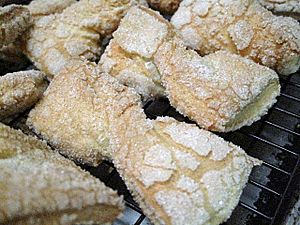Kichel facts for kids
 |
|
| Type | Cookie or cracker |
|---|---|
| Place of origin | Eastern Europe |
| Main ingredients | Eggs, sugar |
Kichel is a light and slightly sweet cookie or cracker. It's a popular treat in Jewish cooking. Kichel is made from simple ingredients like eggs, flour, and sugar. The dough is rolled flat and cut into fun bow-tie shapes.
You can often find Kichel in stores. These are usually dry, bow-tie shaped pastries. They are often sprinkled with sugar. Kichel is a traditional snack served at special gatherings. These gatherings are called kiddush in synagogues. This happens after Shabbat services. Kichel is also a favorite dessert for Rosh Hashanah, the Jewish New Year.
Contents
What is Kichel?
Kichel is a type of cookie or cracker. It is known for being very light and airy. Some people even call these cookies "nothings." This is because they are so light. Kichel has a slightly sweet taste. It is often described as dry. Because of this, people often dip Kichel in a hot drink. Tea is a very popular choice.
How Kichel is Made
Making Kichel starts with a simple dough. The main ingredients are eggs, flour, and sugar. The dough is mixed and then rolled out very thin. After rolling, it is cut into its unique bow-tie shape. These shapes are then baked until they are light and crispy.
Kichel's History and Traditions
Kichlach, the plural of Kichel, first appeared in Eastern Europe. This was in Ashkenazi Jewish communities. This happened around the 1800s. From there, Kichel became popular around the world. This was due to Jewish people moving to new places. This spread happened mostly in the 1900s.
Kichel in Synagogues
In the early 1900s, Kichlach was a main part of kiddush. These were gatherings in Ashkenazi synagogues. People would enjoy Kichlach with other foods. These included pickled herring and schnapps. Even today, Jews in South Africa still eat Kichel. They often serve it with chopped herring. This was also common in American synagogues until the 1950s. Sometimes, Kichlach is eaten with a savory dip.
Kichel for Passover
During the Passover holiday, Jewish people do not eat regular flour. However, Kichlach can still be enjoyed. This is possible if it is made with matzah meal instead of regular flour. This makes it a special treat for the holiday.

